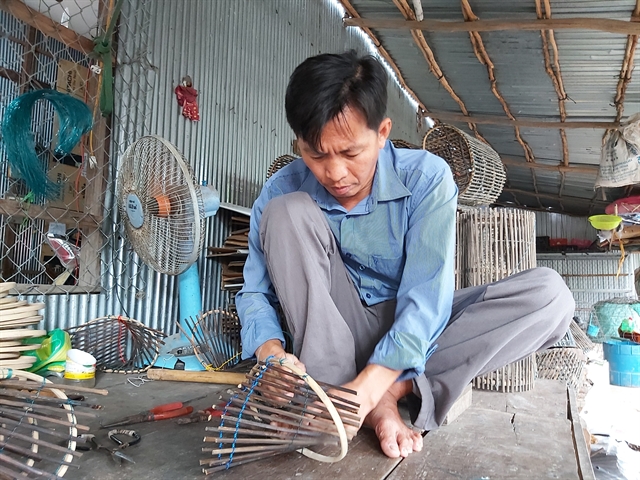 Society
Society

Farmers in the Cửu Long (Mekong) Delta are taking measures to adapt to low levels of flooding this year by switching to new crops and using other cultivation methods.

|
| Nguyễn Quốc Việt in An Giang Province’s An Phú District makes crab-catching traps to sell to fishermen in the Mekong Delta and Cambodia during the flooding season. – VNA/VNS Photo Hồng Nhung |
HCM CITY — Farmers in the Cửu Long (Mekong) Delta are taking measures to adapt to low levels of flooding this year by switching to new crops and using other cultivation methods.
The delta’s annual floods, which are caused by the rising water levels of the Mekong River in the rainy season, have been lower than usual this year.
Besides its impact on agricultural production in these typically flooded areas, the delta’s annual floods bring sediment to fertile fields as well as wild fish and other aquatic species from the upper areas of the Mekong River.
During this period, farmers can also breed aquatic species in flooded rice fields or grow other aquatic crops.
However, this year, the flood waters in Đồng Tháp and An Giang, the delta’s two upstream provinces, have been lower than in previous years.
In Đồng Tháp, the water levels at observation stations in mid-August were 0.5 – 2 metres lower than the same period last year, according to the Đồng Tháp Centre of Hydro-Meteorology Forecasting.
The water level on Tuesday (September 3) was estimated to reach 2.66 metres on the Tiền River at the Tân Châu Station and 2.36 metres on the Hậu River at the Châu Đốc Station in An Giang, according to the National Centre of Hydro-Meteorology Forecasting.
The levels are expected to increase to 2.7 metres at the Tân Châu Station and 2.4 metres at the Châu Đốc Station tomorrow.
Earlier, the centre said that big floods this year would not occur because of low rainfall.
Many farmers have not been able to breed aquatic species in rice fields because of the low level of floods.
Nguyễn Văn Định in Bình Thạnh Commune in Đồng Tháp Province’s Hồng Ngự Town prepared 1 million shrimp fry to breed on 10ha, including 7ha of rice fields, during the flood season.
However, he now has to breed the shrimp on a 3 ha nursing pond because flood waters have not flowed into his rice fields.
If flood waters come late or if there is no flood, he will pump water and use equipment to supply additional oxygen, as well as use industrial feed, to breed shrimp in the 3ha pond.
However, this farming method increases production costs and the shrimp grow more slowly than shrimp bred in flooded fields where they eat natural food.
In Hồng Ngự Town’s Bình Thạnh Commune, rice fields now have no flood water, but last year during the same period fields were covered with two-metre high floods, according to farmers.
Fishermen in the delta’s upstream provinces are also experiencing a poor catch of fish and other aquatic species because of the low level of floods.
In An Giang Province’s An Phú District, Nhơn Hội Commune has about 100 households that make a living on catching aquatic species, especially Siamese mud carps, a specialty of the flooding season, according to the commune’s Farmers Association.
Mai Văn Hai, who has caught Siamese mud carps for 30 years in Nhơn Hội, said he had caught about 10 kilos of the fish daily in late August last year, but has only caught only one-half kilo of the fish daily this year during the same period.
Craft villages that make tools for catching fish and other aquatic species have had to reduce their production because of low demand for the tools.
Nguyễn Quốc Việt in Nhơn Hội said in previous years he could earn a livelihood from making crab-catching traps to sell to fishermen in the delta during the flooding season.
He normally sells about 700 crab-catching traps in big flood seasons and earns a profit of VNĐ14 million (US$600) each season.
However, during this flood season he has only sold 300 crab-catching traps and most of the buyers are fishermen from Cambodia.
Phạm Thành Tâm, deputy head of the An Phú Agriculture and Rural Development Bureau, said many households in fishing-tool making villages had stopped production.
Many labourers in the commune have gone to big cities to find jobs, he said.
Switching crops
Many farmers this year have switched from rice or aquatic species to grow lotus and water caltrop and other crops that do not require too much water.
Ngô Văn Đông in Đồng Tháp’s Hồng Ngự District has stopped growing rice and aquatic species and turned to lotus cultivation.
“Small and big floods do not affect lotus cultivation,” he said.
The profit from growing rice is VNĐ700,000 – VNĐ1 million ($30 - 43) for 1,000 sq.m while the profit for lotus is three times higher, he said.
The delta’s upstream provinces have launched programmes to provide livelihoods for farmers in these typically flood-prone areas.
Võ Thành Ngoan, deputy director of the Đồng Tháp Department of Agriculture and Rural Development, said the province’s agencies have improved the forecasting of flood levels.
Đồng Tháp has long-term plans to adapt to climate change so farmers can work during the flood as well as dry season, he said.
The province has turned ineffective rice fields to zones where other high value crops and fruits can be grown. It has also provided advanced farming techniques to farmers.
An Giang has plans to switch from crops that require high levels of water to crops that need much less.
Trương Kiến Thọ, deputy director of the An Giang Department of Agriculture and Rural Development, said the province has called on companies to promote high-tech farming and support farmers in these areas to switch to crops that require less water. — VNS